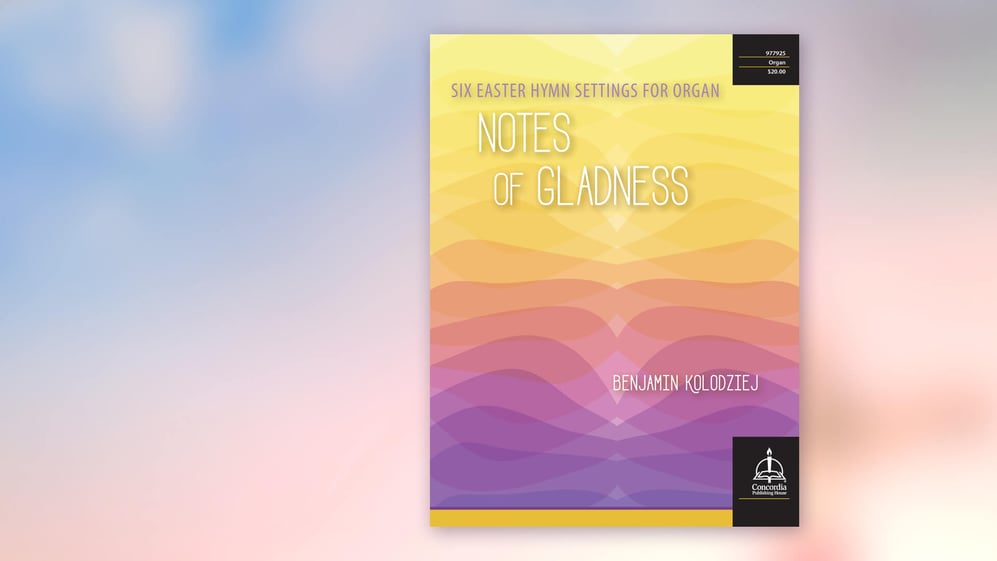This collection by Benjamin Kolodziej features Easter organ settings of moderate difficulty. Each employs various musical textures to convey the spirit of the hymn texts to the congregation. From meditative and lush treatments of LANCASHIRE and VRUECHTEN to a sprightly trio arrangement of BESANÇON to a setting of DUKE STREET suitable for showcasing a solo trumpet, organists will find these settings invigorating and fun to play.
Notes of Gladness: Six Easter Hymn Settings for Organ
As we turn the calendar from March to April this year, the Church turns its focus from Lent to Holy Week, culminating in the Resurrection of Our Lord on Easter Sunday. The season of Easter lasts fifty days, through the Day of Pentecost (this year on May 23). It includes seven Sundays of Easter and the high feast of the Ascension of Our Lord (this year on May 13).
Easter Day and the seven weeks of Easter that follow are an opportunity for church organists to revisit settings of beloved hymns that capture the joy and triumph of the season. Benjamin Kolodziej has compiled six newly published settings of beloved Easter hymns in his collection Notes of Gladness: Six Easter Hymn Settings for Organ.
Since fanfares, marches, and toccatas are already common favorites among organists for Easter hymn settings, Kolodziej said he wanted to approach the hymn tunes in a unique way, but one that still conveyed the text of the hymns and the character of their tunes.
“Personally, I gravitate toward meditative settings as opposed to robust, loud sorts of settings. I enjoy those too; I enjoy the toccata just like anybody else does,” Kolodziej said. “I often found this a challenge because these Easter hymns are so joyous.”
Treatments of the Various Settings
The first two settings in the volume are on the tunes AUF, AUF, MEIN HERZ (LSB 467 “Awake, My Heart, with Gladness”) and BESANÇON (LSB 481 “Scatter the Darkness, Break the Gloom”). These both feature trio textures with bright sixteenth-note patterns.
The settings of LANCASHIRE (LSB 478 “The Day of Resurrection”) and VRUECHTEN (LSB 482 “This Joyful Eastertide”) are distinctly meditative and are suggested for use with quiet solo stops and string and flute accompaniments.
These two hymns are especially appropriate for use throughout the Easter season, so these settings should be useful for the church organist even after Easter Day. “The Day of Resurrection” is an ancient text that is fitting to sing whenever the Resurrection of Our Lord is celebrated—that is, every Lord’s Day, and especially throughout Easter.
“This Joyful Eastertide” conveys the joy of the entire Easter season—the Eastertide. These meditative settings would make fine preservice or offertory music for services throughout the Eastertide this year.
Kolodziej also includes sprightly settings of DUKE STREET (LSB 461 “I Know That My Redeemer Lives”) and HYMN TO JOY (LSB 477 “Alleluia, Alleluia! Hearts to Heaven”). The setting of DUKE STREET can be divided into three movements: the first and third feature a festive trumpet tune to capture the triumph of Easter Day, and a second movement features the melody in a 6/8 meter.
The setting of HYMN TO JOY is composed in two sections: first, with vibrant eighth-note patterns and, second, a toccata that features the melody in the pedal. This setting is fitting for a fuller organ registration and is meant to convey the “quintessential Easter” sound and texture, according to Kolodziej.
Since most congregations weren’t able to gather for Easter Sunday and much of the Easter season last year, the beloved hymns and sounds of Easter will be welcoming to the ears as members gather together this year. Kolodziej’s Notes of Gladness are a fitting addition to the church organist’s repertoire as the Church returns to its more familiar Easter celebrations this month.
To order Notes of Gladness and hear a preview of the songs, click the button below.













.jpg?width=50&height=50&name=IMG_20220621_160541_456%20(1).jpg)
